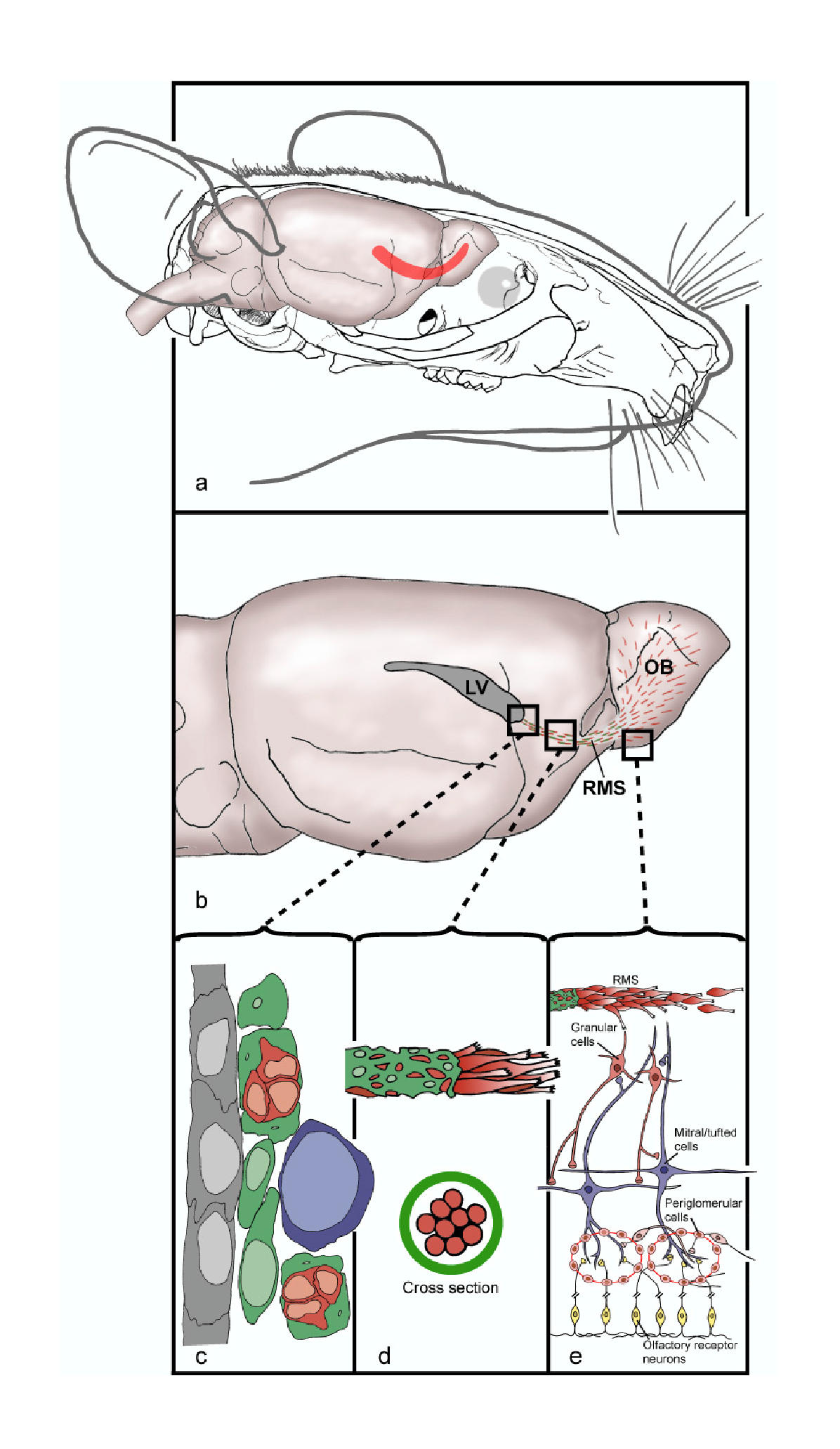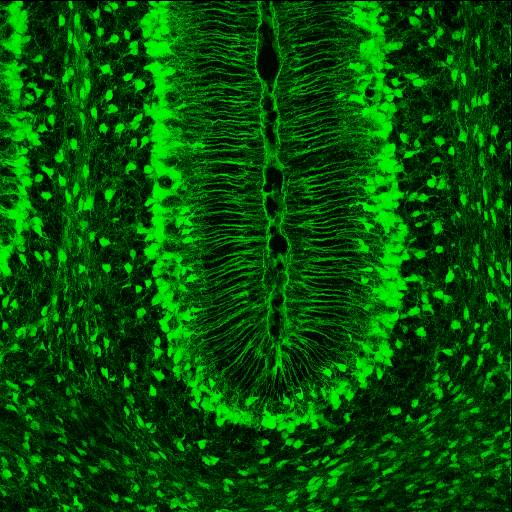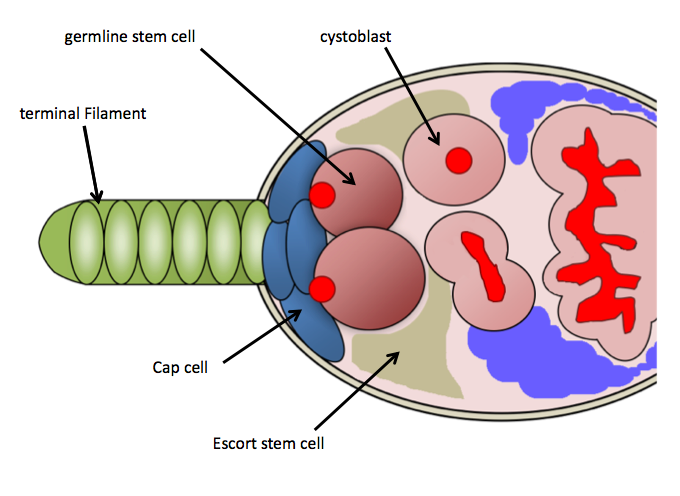|
Intermediate Progenitor Cell
Intermediate progenitor cells (IPCs) are a type of progenitor cell in the developing cerebral cortex. They are multipolar cells produced by radial glial cells who have undergone asymmetric division. IPCs can produce neuron cells via neurogenesis and are responsible for ensuring the proper quantity of cortical neurons are produced. In mammals, neural stem cells are the primary progenitors during embryogenesis whereas intermediate progenitor cells are the secondary progenitors. Function Neurogenesis is a vital part of embryonic development. IPCs divide symmetrically, primarily in the subventricular zone (SVZ) of the neuroepithelium to produce either a new pair of IPC's or a pair of neurons. Fully developed neurons are most likely targeted to the upper cortical layers. Recent studies have shown that IPC's are activated by similar factors in both adult and embryonic development, challenging the early notion that they were only needed in embryogenesis. Neurogenesis is also a two-tier ... [...More Info...] [...Related Items...] OR: [Wikipedia] [Google] [Baidu] |
Progenitor Cell
A progenitor cell is a biological cell that can differentiate into a specific cell type. Stem cells and progenitor cells have this ability in common. However, stem cells are less specified than progenitor cells. Progenitor cells can only differentiate into their "target" cell type. The most important difference between stem cells and progenitor cells is that stem cells can replicate indefinitely, whereas progenitor cells can divide only a limited number of times. Controversy about the exact definition remains and the concept is still evolving. The terms "progenitor cell" and "stem cell" are sometimes equated. Properties Most progenitors are identified as oligopotent. In this point of view, they can compare to adult stem cells, but progenitors are said to be in a further stage of cell differentiation. They are in the "center" between stem cells and fully differentiated cells. The kind of potency they have depends on the type of their "parent" stem cell and also on their niche. ... [...More Info...] [...Related Items...] OR: [Wikipedia] [Google] [Baidu] |
Rostral Migratory Stream
The rostral migratory stream (RMS) is a specialized migratory route found in the brain of some animals along which neuronal precursors that originated in the subventricular zone (SVZ) of the brain migrate to reach the main olfactory bulb (OB). The importance of the RMS lies in its ability to refine and even change an animal's sensitivity to smells, which explains its importance and larger size in the rodent brain as compared to the human brain, as our olfactory sense is not as developed. This pathway has been studied in the rodent, rabbit, and both the squirrel monkey and rhesus monkey. When the neurons reach the OB they differentiate into GABAergic interneurons as they are integrated into either the granule cell layer or periglomerular layer. Although it was originally believed that neurons could not regenerate in the adult brain, neurogenesis has been shown to occur in mammalian brains, including those of primates. However, neurogenesis is limited to the hippocampus and SV ... [...More Info...] [...Related Items...] OR: [Wikipedia] [Google] [Baidu] |
Radial Glial Cell
Radial glial cells, or radial glial progenitor cells (RGPs), are bipolar-shaped progenitor cells that are responsible for producing all of the neurons in the cerebral cortex. RGPs also produce certain lineages of glia, including astrocytes and oligodendrocytes. Their cell bodies ( somata) reside in the embryonic ventricular zone, which lies next to the developing ventricular system. During development, newborn neurons use radial glia as scaffolds, traveling along the radial glial fibers in order to reach their final destinations. Despite the various possible fates of the radial glial population, it has been demonstrated through clonal analysis that most radial glia have restricted, unipotent or multipotent, fates. Radial glia can be found during the neurogenic phase in all vertebrates (studied to date). The term "radial glia" refers to the morphological characteristics of these cells that were first observed: namely, their radial processes and their similarity to astrocytes, ... [...More Info...] [...Related Items...] OR: [Wikipedia] [Google] [Baidu] |
Neurogenesis
Neurogenesis is the process by which nervous system cells, the neurons, are produced by neural stem cells (NSCs). It occurs in all species of animals except the porifera (sponges) and placozoans. Types of NSCs include neuroepithelial cells (NECs), radial glial cells (RGCs), basal progenitors (BPs), intermediate neuronal precursors (INPs), subventricular zone astrocytes, and subgranular zone radial astrocytes, among others. Neurogenesis is most active during embryonic development and is responsible for producing all the various types of neurons of the organism, but it continues throughout adult life in a variety of organisms. Once born, neurons do not divide (see mitosis), and many will live the lifespan of the animal. Neurogenesis in mammals Developmental neurogenesis During embryonic development, the mammalian central nervous system (CNS; brain and spinal cord) is derived from the neural tube, which contains NSCs that will later generate neurons. However, neurogenesis d ... [...More Info...] [...Related Items...] OR: [Wikipedia] [Google] [Baidu] |
Progenitor Cell
A progenitor cell is a biological cell that can differentiate into a specific cell type. Stem cells and progenitor cells have this ability in common. However, stem cells are less specified than progenitor cells. Progenitor cells can only differentiate into their "target" cell type. The most important difference between stem cells and progenitor cells is that stem cells can replicate indefinitely, whereas progenitor cells can divide only a limited number of times. Controversy about the exact definition remains and the concept is still evolving. The terms "progenitor cell" and "stem cell" are sometimes equated. Properties Most progenitors are identified as oligopotent. In this point of view, they can compare to adult stem cells, but progenitors are said to be in a further stage of cell differentiation. They are in the "center" between stem cells and fully differentiated cells. The kind of potency they have depends on the type of their "parent" stem cell and also on their niche. ... [...More Info...] [...Related Items...] OR: [Wikipedia] [Google] [Baidu] |
BTG2
Protein BTG2 also known as BTG family member 2 or NGF-inducible anti-proliferative protein PC3 or NGF-inducible protein TIS21, is a protein that in humans is encoded by the ''BTG2'' gene (B-cell translocation gene 2) and in other mammals by the homologous ''Btg2'' gene. This protein controls cell cycle progression and proneural genes expression by acting as a transcription coregulator that enhances or inhibits the activity of transcription factors. The protein BTG2 is the human homolog of the PC3 (pheochromocytoma cell 3) protein in rat and of the Tis21 (tetradecanoyl phorbol acetate-inducible sequence 21) protein in mouse. ''Tis21'' had been originally isolated as a sequence induced by 12-O-Tetradecanoylphorbol-13-acetate, TPA in mouse fibroblasts, whereas ''PC3'' was originally isolated as sequence induced at the beginning of neuron differentiation; ''BTG2'' was then isolated in human cells as sequence induced by p53 and DNA damage. The protein encoded by the gene BTG2 (which i ... [...More Info...] [...Related Items...] OR: [Wikipedia] [Google] [Baidu] |
NFIX
Nuclear factor 1 X-type is a protein that in humans is encoded by the ''NFIX'' gene. NFI-X3, a splice variant of NFIX, regulates Glial fibrillary acidic protein and YKL-40 in astrocytes. Interactions Nfix has been shown to interact with SKI protein and it is also known to interact with AP-1. NFI-X3 has been shown to interact with STAT3. In embryonic cells, Nfix has been shown to regulate intermediate progenitor cell (IPC) generation by promoting the transcription of the protein inscuteable (INSC). INSC regulates spindle orientation to facilitate the division of radial glia cells into IPC's. Nfix is thought to be necessary for the commitment of glia progeny into the intermediate progenitors. Mutations may cause overproduction of radial glia, impaired and improperly timed IPC development, and underproduction of neurons. In adult development, the timing of neural differentiation is regulated by Nfix to promote ongoing growth of the hippocampus and proper memory function ... [...More Info...] [...Related Items...] OR: [Wikipedia] [Google] [Baidu] |
Biochemical Cascade
A biochemical cascade, also known as a signaling cascade or signaling pathway, is a series of chemical reactions that occur within a biological cell when initiated by a stimulus. This stimulus, known as a first messenger, acts on a receptor that is transduced to the cell interior through second messengers which amplify the signal and transfer it to effector molecules, causing the cell to respond to the initial stimulus. Most biochemical cascades are series of events, in which one event triggers the next, in a linear fashion. At each step of the signaling cascade, various controlling factors are involved to regulate cellular actions, in order to respond effectively to cues about their changing internal and external environments. An example would be the coagulation cascade of secondary hemostasis which leads to fibrin formation, and thus, the initiation of blood coagulation. Another example, sonic hedgehog signaling pathway, is one of the key regulators of embryonic development a ... [...More Info...] [...Related Items...] OR: [Wikipedia] [Google] [Baidu] |
Eomesodermin
Eomesodermin also known as T-box brain protein 2 (Tbr2) is a protein that in humans is encoded by the ''EOMES'' gene. The Eomesodermin/Tbr2 gene, ''EOMES'', encodes a member of a Conserved sequence, conserved protein family that shares a common DNA-binding domain, the T-box transcription factor TBX1, T-box. T-box genes encode transcription factors, which control gene expression, involved in the regulation of developmental processes. Eomesodermin/Tbr2 itself controls regulation of Neural stem cell, radial glia, as well as other related cells. Eomesodermin/Tbr2 has also been found to have a role in Immune system, immune response, and there exists some loose evidence for its connections in other systems. Nervous system development Neurogenesis Eomesodermin/Tbr2 is expressed highly in the intermediate progenitor stage of the developing neuron. Neurons, the primary functional cells of the brain, are developed from Radial glial cell, radial glia cells. This process of cells deve ... [...More Info...] [...Related Items...] OR: [Wikipedia] [Google] [Baidu] |
Stem-cell Niche
Stem-cell niche refers to a microenvironment, within the specific anatomic location where stem cells are found, which interacts with stem cells to regulate cell fate. The word 'niche' can be in reference to the ''in vivo'' or ''in vitro'' stem-cell microenvironment. During embryonic development, various niche factors act on embryonic stem cells to alter gene expression, and induce their proliferation or differentiation for the development of the fetus. Within the human body, stem-cell niches maintain adult stem cells in a quiescent state, but after tissue injury, the surrounding micro-environment actively signals to stem cells to promote either self-renewal or differentiation to form new tissues. Several factors are important to regulate stem-cell characteristics within the niche: cell–cell interactions between stem cells, as well as interactions between stem cells and neighbouring differentiated cells, interactions between stem cells and adhesion molecules, extracellular matrix co ... [...More Info...] [...Related Items...] OR: [Wikipedia] [Google] [Baidu] |
Olfactory Bulb
The olfactory bulb (Latin: ''bulbus olfactorius'') is a neural structure of the vertebrate forebrain involved in olfaction, the sense of smell. It sends olfactory information to be further processed in the amygdala, the orbitofrontal cortex (OFC) and the hippocampus where it plays a role in emotion, memory and learning. The bulb is divided into two distinct structures: the main olfactory bulb and the accessory olfactory bulb. The main olfactory bulb connects to the amygdala via the piriform cortex of the primary olfactory cortex and directly projects from the main olfactory bulb to specific amygdala areas. The accessory olfactory bulb resides on the dorsal-posterior region of the main olfactory bulb and forms a parallel pathway. Destruction of the olfactory bulb results in ipsilateral anosmia, while irritative lesions of the uncus can result in olfactory and gustatory hallucinations. Structure In most vertebrates, the olfactory bulb is the most rostral (forward) part o ... [...More Info...] [...Related Items...] OR: [Wikipedia] [Google] [Baidu] |
Cortical Layers
The cerebral cortex, also known as the cerebral mantle, is the outer layer of neural tissue of the cerebrum of the brain in humans and other mammals. The cerebral cortex mostly consists of the six-layered neocortex, with just 10% consisting of allocortex. It is separated into two cortices, by the longitudinal fissure that divides the cerebrum into the left and right cerebral hemispheres. The two hemispheres are joined beneath the cortex by the corpus callosum. The cerebral cortex is the largest site of neural integration in the central nervous system. It plays a key role in attention, perception, awareness, thought, memory, language, and consciousness. The cerebral cortex is part of the brain responsible for cognition. In most mammals, apart from small mammals that have small brains, the cerebral cortex is folded, providing a greater surface area in the confined volume of the cranium. Apart from minimising brain and cranial volume, cortical folding is crucial for the brain ... [...More Info...] [...Related Items...] OR: [Wikipedia] [Google] [Baidu] |






